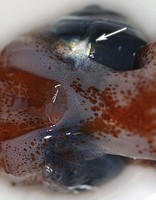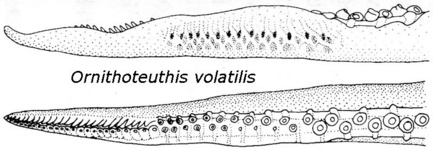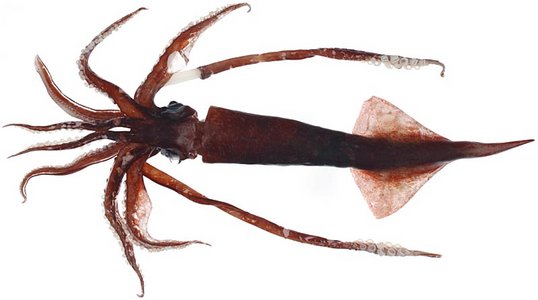Ornithoteuthis
Bird squid
Richard E. Young and Michael Vecchione


This tree diagram shows the relationships between several groups of organisms.
The root of the current tree connects the organisms featured in this tree to their containing group and the rest of the Tree of Life. The basal branching point in the tree represents the ancestor of the other groups in the tree. This ancestor diversified over time into several descendent subgroups, which are represented as internal nodes and terminal taxa to the right.

You can click on the root to travel down the Tree of Life all the way to the root of all Life, and you can click on the names of descendent subgroups to travel up the Tree of Life all the way to individual species.
For more information on ToL tree formatting, please see Interpreting the Tree or Classification. To learn more about phylogenetic trees, please visit our Phylogenetic Biology pages.
close boxIntroduction
These are relatively small (about 100-200 mm ML) and highly agile ommastrephids that do not seem to be common anywhere. Their taxonomic characteristics are very different from other members of the subfamily.
Brief diagnosis:
An ommastrephin ...
- with mantle and fins drawn out into a narrow tail.
- with luminous stripe along midline on viscera.
Characteristics
- Tentacles
- Arms tips in subadults not unusually attenuate; arms I with 25-30 pairs of suckers (Wormuth, 1976).
- Carpal locking-apparatus absent from tentacles (unique in subfamily).
- Largest club suckers with ca. 20 uniform, broadly spaced, small teeth (unique in subfamily).
 Click on an image to view larger version & data in a new window
Click on an image to view larger version & data in a new window
Figure. Oral view of the inner sucker ring of a large club sucker from Ornithoteuthis volitalis. Drawing from Roeleveld (1988).
- Funnel
- Mantle component of the funnel/mantle locking-apparatus without anterior bifurcation.
- Funnel groove with foveola, with or without side pockets.
- Mantle
- Mantle slender, drawn out into narrow tail (unique in subfamily).
- Mantle slender, drawn out into narrow tail (unique in subfamily).
- Fins
- Fins narrowly drawn out along tail.
- Fins narrowly drawn out along tail.
- Photophores
- Small subcutaneous photophores absent. Absence of large or small subcutaneous unique in subfamily).
- Luminous patch present on ventral surface of each eye.
- Visceral photophores present: two intestinal photophores and an elongate luminous stripe along midline on viscera (unique in family).



Figure. Photophores of Ornithoteuthis antillarum. Left - Ventral view of the mantle cavity of showing the visceral photophores. Left arrow points to an elongate luminous strip. Right two arrows point to intestinal photophores. Note that the anterior visceral photophore appears to have a different structure than the posterior one. Right - Ventral view of the head of the same squid showing the ocular photophore on the right eye. Photographs by M. Vecchione.
Comments
Comparison of species (Dunning, 1998):
| Sexual dimorphism, arm sucker dentition | Hectocotylus: number of longitudinal series of depressions | Hectocotylus: number of depressions per transverse row | Distribution | |
| O. volatilis | No | 2-3 | 10-15 | IndoPacific, eastern tropical Atlantic |
| O. antillarum | Yes | 4-5 | 20-25 | Western tropical Atlantic |



Figure. Ventrolateral and oral views of the hectocotylus of Ornithoteuthis spp. Top - O. volatilis. Drawing from Roeleveld (1988). Bottom - O. antillarum. Drawing from Voss (1957). Unfortunately the specific differences in hectocotylus structure are not well illustrated by these figures.
References
Dunning, M. C. 1998. A Review of the systematics, distribution, and biology of the arrow squid genera Ommastrephes Orbigny, 1835, Sthenoteuthis Verrill, 1880, and Ornithoteuthis Okada, 1927 (Cephalopoda: Ommastrephidae). Smiths. Contr. Zool., No. 586: 425-433.
Roeleveld, M. A. 1988. Generic interrelationships within the Ommastrephidae (Cephalopoda). P.277-314. In: M. R. Clarke and E. R. Trueman (eds.). The Mollusca. Vol. 12. Paleontology and Neontology of Cephalopods. Academic Press, N.Y., 355pp.
Sasaki, M. 1929. A Monograph of the Dibranchiate Cephalopods of the Japanese and Adjacent Waters. Journal of the College of Agriculture, Hokkaido Imperial University, 20(supplement):357 pages.
Voss, G.L. 1957. Observations on Ornithoteuthis antillarum adam, 1957. An ommastrephid ssquid from the West Indies. Bulletin of Marine Science of the Gulf and Caribbean, 7(4):370-378.
About This Page

University of Hawaii, Honolulu, HI, USA

National Museum of Natural History, Washington, D. C. , USA
Page copyright © 2017 and
 Page: Tree of Life
Ornithoteuthis . Bird squid.
Authored by
Richard E. Young and Michael Vecchione.
The TEXT of this page is licensed under the
Creative Commons Attribution-NonCommercial License - Version 3.0. Note that images and other media
featured on this page are each governed by their own license, and they may or may not be available
for reuse. Click on an image or a media link to access the media data window, which provides the
relevant licensing information. For the general terms and conditions of ToL material reuse and
redistribution, please see the Tree of Life Copyright
Policies.
Page: Tree of Life
Ornithoteuthis . Bird squid.
Authored by
Richard E. Young and Michael Vecchione.
The TEXT of this page is licensed under the
Creative Commons Attribution-NonCommercial License - Version 3.0. Note that images and other media
featured on this page are each governed by their own license, and they may or may not be available
for reuse. Click on an image or a media link to access the media data window, which provides the
relevant licensing information. For the general terms and conditions of ToL material reuse and
redistribution, please see the Tree of Life Copyright
Policies.
- First online 29 November 2009
- Content changed 29 November 2009
Citing this page:
Young, Richard E. and Michael Vecchione. 2009. Ornithoteuthis . Bird squid. Version 29 November 2009 (under construction). http://tolweb.org/Ornithoteuthis/19942/2009.11.29 in The Tree of Life Web Project, http://tolweb.org/







 Go to quick links
Go to quick search
Go to navigation for this section of the ToL site
Go to detailed links for the ToL site
Go to quick links
Go to quick search
Go to navigation for this section of the ToL site
Go to detailed links for the ToL site